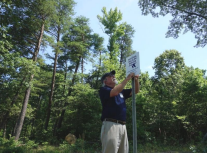The panoramic view from Fones Cliffs above the Rappahannock River in Virginia. The 252 acre property is now part of the Rappahannock River Valley National Wildlife Refuge. (All photos: Pamela A. D’Angelo for theFree Lance-Star)
Last Friday, Joe McCauley installed a  ceremonial US Fish and Wildlife Service boundary marker on a 252 acre property at Fones Cliffs. It was the culmination of more than a decade of Joe’s persistence.
ceremonial US Fish and Wildlife Service boundary marker on a 252 acre property at Fones Cliffs. It was the culmination of more than a decade of Joe’s persistence.
Protecting this vital piece of Fones Cliffs–a spectacular cultural, scenic and ecological resource above the Rappahannock River– was the work of many, like a lot of conservation projects. In this case, The Conservation Fund acquired the property, which had long been threatened with development, and transferred it to become part of the Rappahannock River Valley National Wildlife Refuge. The property also sits along the Captain John Smith Chesapeake National Historic Trail.
On Friday, June 28, The Conservation Fund, Rappahannock Tribe Chief Anne Richardson, Congressman Rob Wittman, US Fish and Wildlife Service officials, state and federal officials, the Chesapeake Conservancy, and others gathered to celebrate the transfer. “The significance of preserving the Fones Cliffs property goes beyond environmental conservation,” said Larry Selzer, President and CEO at The Conservation Fund. “It is a critical stepping stone in our nation’s history. Ensuring that Fones Cliffs remains protected and open to the public was the only acceptable result for this decade-long effort.”
Fones Cliffs was once home to three American Indian towns and it retains great significance to the Rappahannock people today. “We are so pleased to see this portion of the Cliffs protected from development,” said Chief Anne Richardson. “This is the land where our ancestors lived for thousands of years and it is sacred to our Tribe. Thanks to all the partners who understand how essential land preservation is to our very existence.”
Joe McCauley, formerly the refuge manager and later chief of realty for the Fish & Wildlife Service’s Northeast Region, and now Chesapeake Fellow with the Chesapeake Conservancy, began working to protect Fones Cliffs back in 2004. “It means a tremendous amount to me” to see this land conserved, Joe said. “So many people were involved in it, so many people kept the faith when it would have been easy to give up.”
Joe was also a founding member of the Chesapeake Conservation Partnership, and played a key role in the Partnership’s efforts to secure increased funding from the Land and Water Conservation Fund (LWCF) through the Partnership’s Rivers of the Chesapeake Collaborative Initiative. Years of that effort, coordinated by the Chesapeake Conservancy, paid off and the protection of Fones Cliffs was secured with LWCF funding, which uses a portion of offshore energy revenue to fund conservation at no cost to taxpayers.
For more on this story, see this article in the Free Lance-Star.
Lightning Update is a regular communication of the Chesapeake Conservation Partnership. Any opinions expressed are those of the authors and do not necessarily reflect positions of the Partnership or member organizations.
To share a success story, news, or important event, send your information to:
Support for the Chesapeake Conservation Partnership is provided by:
National Park Service Chesapeake
EPA Chesapeake Bay Program
USDA Forest Service
Pennsylvania Department of Conservation & Natural Resources
Maryland Department of Natural Resources
Virginia Outdoors Foundation
US Fish & Wildlife Service
Chesapeake Conservancy
The Chesapeake Conservation Partnership is co-convened by:




